Lessico
Apio
/ Appio
Sedano / Apium graveolens
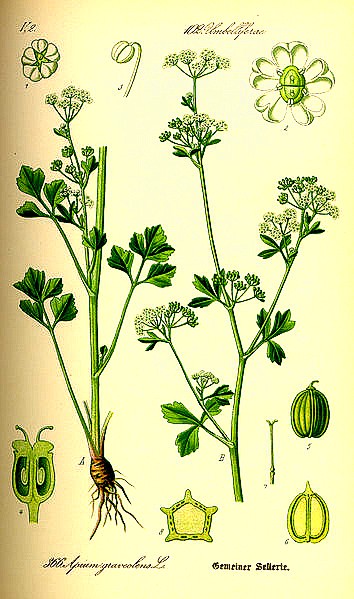
Al genere Apium
della famiglia Ombrellifere appartengono due piante che in italiano vanno
sotto il nome di apio o appio: il sedano - Apium graveolens - che
cresce spontaneo nei luoghi erbosi palustri e la sedanina d’acqua - Apium
nodiflorum![]() - propria dell'Europa, Asia centrale e Africa nord-orientale,
abbastanza frequente nelle paludi e lungo i fossi, dalla pianura alla zona
submontana, anch’essa aromatica in ogni sua parte come il sedano.
- propria dell'Europa, Asia centrale e Africa nord-orientale,
abbastanza frequente nelle paludi e lungo i fossi, dalla pianura alla zona
submontana, anch’essa aromatica in ogni sua parte come il sedano.
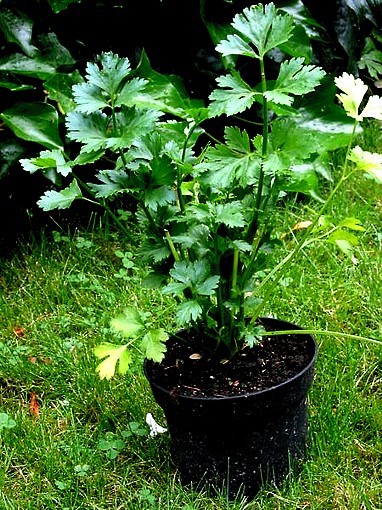
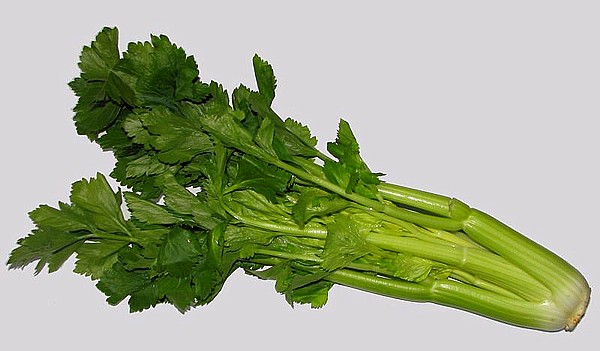
Apium graveolens is a plant species in the family Apiaceae, and yields two important vegetables known as celery and celeriac. Cultivars of the species have been used for centuries, whilst others have been domesticated only in the last 200-300 years. The petiole is the part consumed.
Celery was officially described by Carolus Linnaeus in Volume One of his Species Plantarum in 1753. The closely related Apium bermejoi from the island of Minorca is one of the rarest plants in Europe with only 60 individuals left.
Uses
Apium graveolens is used around the world as a vegetable, either for the crisp petiole (leaf stalk) or fleshy taproot. In temperate countries, celery is also grown for its seeds, which yield a valuable volatile oil used in the perfume and pharmaceutical industries. Celery seeds can be used as flavouring or spice either as whole seeds or, ground and mixed with salt, as celery salt. Celery salt can also be made from an extract of the roots. Celery Salt is used as a seasoning, in cocktails (notably to enhance the flavour of Bloody Mary cocktails), on the Chicago-style hot dog, and in Old Bay Seasoning.
Celery is one of three vegetables considered the holy trinity (along with onions and bell peppers) of Louisiana Creole and Cajun cuisine. It is also one of the three vegetables (together with onions and carrots) that constitute the French mirepoix, which is often used as a base for sauces and soups.
Medicine
The use of celery seed in pills for relieving pain was described by Aulus Cornelius Celsus ca. 30 AD. The whole plant is gently stimulating, nourishing, and restorative; it can be liquidized and the juice taken for joint and urinary tract inflammations, such as rheumatoid arthritis, cystitis or urethritis, for weak conditions and nervous exhaustion.
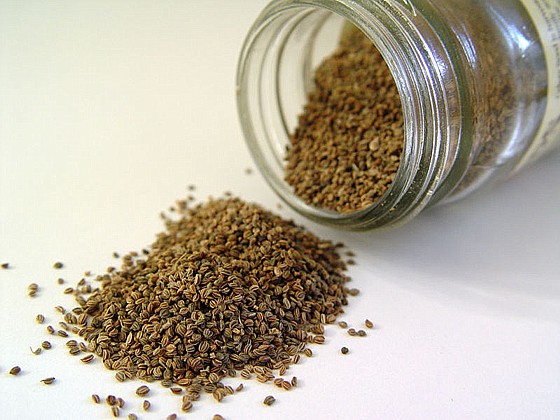
Celery seeds
The root is an effective diuretic and has been taken for urinary stones and gravel. It also acts as a bitter digestive remedy and liver stimulant. A tincture can be used as a diuretic in hypertension and urinary disorders, as a component in arthritic remedies, or as a kidney energy stimulant and cleanser. Celery roots, fruits (seeds), and aerial parts, are used ethnomedically to treat mild anxiety and agitation, loss of appetite, fatigue, cough, and as an anthelmintic (vermifuge).
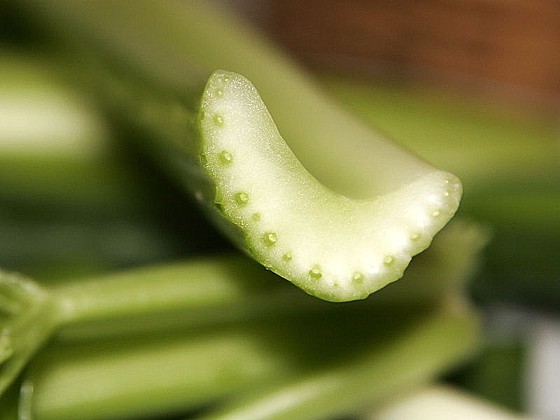
Cross-section of a Pascal celery stalk
Nutrition
There is a common belief that celery is so difficult for humans to digest, that it has 'negative calories' because human digestion burns more calories than can be extracted. Snopes believes this to be true, however at only 6 calories per stalk, the effect is negligible. Celery is still valuable in diets, where it provides low-calorie fiber bulk. Celery contains androsterone. Bergapten in the seeds can increase photosensitivity, so the use of essential oil externally in bright sunshine should be avoided. The oil and large doses of seeds should be avoided during pregnancy: they can act as a uterine stimulant. Seeds intended for cultivation are not suitable for eating as they are often treated with fungicides.
Allergic responses
Although many people enjoy foods made with celery, a small minority of people can have severe allergic reactions. For people with celery allergy, exposure can cause potentially fatal anaphylactic shock. The allergen does not appear to be destroyed at cooking temperatures. Celery root —commonly eaten as celeriac, or put into drinks — is known to contain more allergen than the stalk. Seeds contain the highest levels of allergen content. Celery is amongst a small group of foods (headed by peanuts) that appear to provoke the most severe allergic reactions (anaphylaxis). Exercise-induced anaphylaxis may be exacerbated. An allergic reaction also may be triggered by eating foods that have been processed with machines that have previously processed celery, making avoiding such foods difficult. In contrast with peanut allergy being most prevalent in the US, celery allergy is most prevalent in Central Europe.[6] In the European Union, foods that contain or may contain celery, even in trace amounts, have to be clearly marked as such.
History
Zohary and Hopf note that celery leaves and inflorescences were part of the garlands found in the tomb of Tutankhamun, pharaoh of ancient Egypt, and celery mericarps dated to the 7th century BC were recovered in the Heraion of Samos. However, they note "since Apium graveolens grows wild in these areas it is hard to decide whether these remains represent wild or cultivated forms." Only by classical times is it certain that celery was cultivated.
M. Fragiska mentions another archaeological find of celery, dating to the 9th century BC, at Kastanas; however, the literary evidence for ancient Greece is far more abundant. In Homer's Iliad, the horses of Myrmidons graze on wild celery that grows in the marshes of Troy, and in Odyssey there is mention of the meadows of violet and wild celery surrounding the cave of Calypso.
Cultural depictions
A chthonian symbol, celery was said to have sprouted from the blood of Kadmilos, father of the Cabers, chthonian divinities celebrated in Samothrace, Lemnos and Thebes. The spicy odour and dark leaf colour encouraged this association with the cult of death. In classical Greece celery leaves were used as garlands for the dead, and the wreaths of the winners at the Isthmian Games were first made of celery before being replaced by crowns made of pine. According to Pliny the Elder (Natural History XIX.46), in Archaia the garland worn by the winners of the sacred contest at Nemea was also made of celery.
In the popular television show, Doctor Who, the fifth Doctor, played by Peter Davison, often wore a piece of celery on his lapel.
The Class B Michigan-Ontario League, a minor league baseball league from the early 20th century, included a team called the Kalamazoo Celery Pickers.
Dr. Brown's makes a celery-flavoured soft drink called Cel-Ray.
Foley artists break stalks of celery into a microphone to simulate the sound of breaking bones.
Fans of Chelsea Football Club, Adelaide United, and Central District Bulldogs have been known to sing a saucy song in which they suggest they might use a "lump of celery" in order to tickle a lady's behind: "Celery, Celery, If she don't come, we'll tickle her bum with a lump of celery".
There is a small farming community with the name Celeryville outside Willard, Ohio once known for its large yield of celery.
Mr. Celery is one of the mascots for the Wilmington Blue Rocks.
Cultivation
Apium graveolens grows to 1 m (3 ft) tall. The leaves are pinnate to bipinnate leaves with rhombic leaflets 3-6 cm long and 2-4 cm broad. The flowers are creamy-white, 2-3 mm diameter, produced in dense compound umbels. The seeds are broad ovoid to globose, 1.5-2 mm long and wide.
In North America, commercial production of celery is dominated by a variety called Pascal celery. Gardeners can grow a range of cultivars, many of which differ little from the wild species, mainly in having stouter leaf stems. They are ranged under two classes, white and red; the white cultivars being generally the best flavoured, and the most crisp and tender.
The wild form of celery is known as smallage. It has a furrowed stalk with wedge-shaped leaves, the whole plant having a coarse, rank taste, and a peculiar smell. With cultivation and blanching, the stalks lose their acidic qualities and assume the mild, sweetish, aromatic taste particular to celery as a salad plant.
The plants are raised from seed, sown either in a hot bed or in the open garden according to the season of the year, and after one or two thinnings out and transplantings they are, on attaining a height of 15-20 cm, planted out in deep trenches for convenience of blanching, which is affected by earthing up to exclude light from the stems.
In the past, celery was grown as a vegetable for winter and early spring; because of its antitoxic properties, it was perceived as a cleansing tonic, welcomed after the stagnation of winter.
Harvesting and storage
Harvesting occurs when the average size of celery in a field is marketable; due to extremely uniform crop growth, fields are harvested only once. Petioles and leaves are removed and harvested celery are packed by size and quality (determined by color, shape, straightness and thickness of petiole, stalk and midrib length and absence of disease, cracks, splits, insect damage and rot). When properly stored in optimal conditions, celery can be stored for up to seven weeks between 0 to 2°C (32 to 36°F). Inner stalks may continue growing if kept at temperatures above 0°C (32°F). Freshly-cut petioles of celery are prone to decay, which can be prevented or reduced through the use of sharp blades during processing, gentle handling and proper sanitation.
Apium nodiflorum
Famiglia: Apiaceae
Nome volgare: Sedanina d'acqua
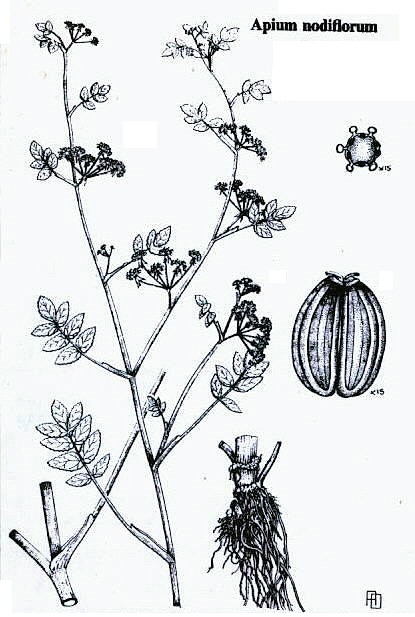
Habitat: Fossi, stagni e pozze sino a 1200 mt
Pianta perenne alta sino a 1 mt, con fusto cavo, striato, ramoso, prostrato ascendente; foglie imparipennate con 7-13 segmenti lanceolati, ovati o subrotondi, regolarmente dentati; fiori in ombrelle a 5-12 raggi, ai nodi del fusto, petali bianco-verdastri, fiorisce da maggio a luglio; il frutto è ovoideo-globoso e appare in agosto-settembre.
Il nome Apium deriverebbe dalla parola celtica apon = acqua per l'habitat di crescita, mentre secondo un'altra teoria deriverebbe dal latino apis = ape perché si riteneva che questi insetti ne fossero attratti.
In cucina sono utilizzate le foglie, reperibili in tutto l'arco dell'anno, crude in insalata oppure cotte insieme ad altre verdure. Nella medicina popolare il decotto di tutte le parti o della sola radice è considerato un buon diuretico e sfiammante, soprattutto dei reni e delle vie urinarie.
www.assms.it
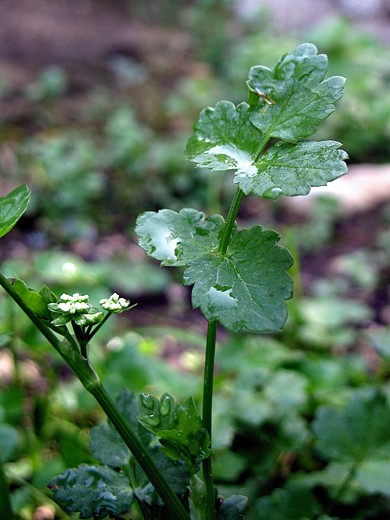
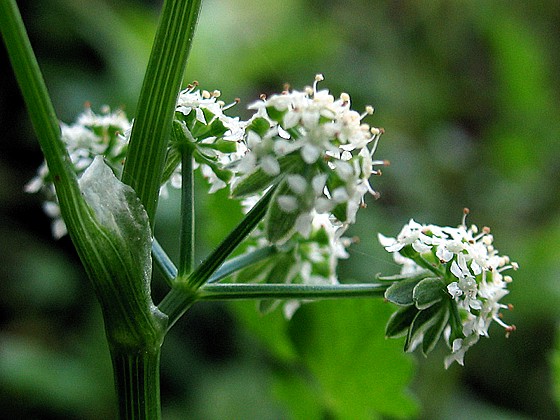
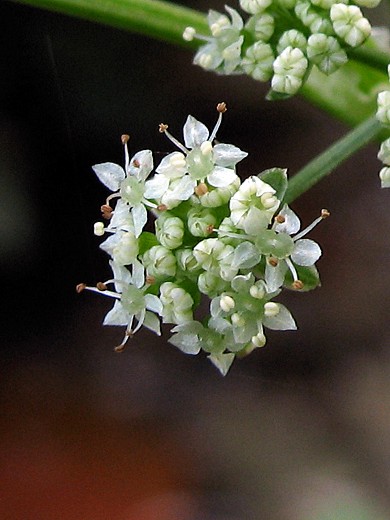
Fools watercress
Apium nodiflorum: flowering from nodes.
Type:
glaborous, perennial.
Taste: nauseous.
Stems: procumbent or ascending, rooting at lower nodes, flring stems rooting at base, hollow, finely grooved. Height: 30-100cm
Umbels: compound, sessile or shortly procumbent. 3-15, 1-2 cmrays, subequal, scabrid, spreading or recurved (0.3) 1-2 cm.Peduncles < than rays; or almost absent, leaf opposed.
Leaves: simply pinnate, bright green, shiny. 2-4 (6) pairs oflobes, 1.5-6 (10) cm, lanceolate to ovate, serrate or crenatesomewhat lobed, sessile. Cotyledons contracted into petiole.
Bracts: absent. Bracteoles 4-7, linear lancolate to ovate, = or >than flowers.
Flowers: greenish white. Styles form a stylopodium. Fl.7-8.
Fruit: 2-2.5 mm ovoid, laterally compressed, smooth. Commisure narrow. Mericarps with prominent thick ribs. Carpophore present. Vittae solitary. Pedicels 1-2 mm. Styles > than stylopodium, recurved, stigma a small knob. 2n=22*
Habitat: ditches, shallow ponds, wet places. Nutrient rich calcerous soil.
Distribution: native, <300m. Common Britain. Rare Scot. C.& S. Europe. W.& C. Asia. N. Africa.
Edible uses: West Country, in pies, pasties. Culpepper: “A diet drink, mix with watercress.”
www.spookspring.com